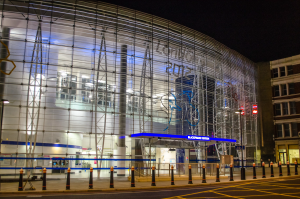Blackfriars Bridge & Station RefurbishmentWinner of a CEEQUAL Outstanding Achievement Award 2013 for Energy & Carbon |
|
Whole Project with Interim Award
Project Team
Client: Network Rail
Design: Jacobs Engineering, Tony Gee & Partners
Construction: Balfour Beatty Civil Engineering Ltd
The Project
As part of the Network Rail £6 billion Thameslink Programme, Blackfriars Station was transformed in order to facilitate increased Thameslink train and passenger capacity (50% longer trains and trebling of frequency, equalling 14,500 extra passengers a day in 2018). At Blackfriars the 1886 Victorian railway bridge was transformed to create a new landmark and is now the first UK station to span a river — the River Thames. The station with its new entrance on the south bank, the first building constructed in this location for over 120 years, will now also provide passengers with direct access to the area’s leading cultural attractions.

Challenges faced
The improvements being made at Blackfriars station will not only provide a better journey experience for passengers but also provide a more sustainable station.
To help the station become more sustainable, over 6,000m² of solar photovoltaic (PV) panels were incorporated onto the new roof of the historic structure; making it the largest roof array in the UK. The installation was complex, working over a river and next to live overground and underground railways, but with the help of the CEEQUAL process this was overcome. The roof will provide 1.058MW of renewable electricity at its peak (up to 50% of the stations energy) powering lighting, ticket machines, staff accommodation and office facilities with any excess electricity being fed back into the National Grid. The energy generated by the cells will reduce carbon dioxide emissions by 550 tonnes a year, equivalent to flying from London Heathrow to Paris (return per passenger trip) approximately 4508 times.
The project took full advantage of its unique location and was able to use barges to remove and deliver materials via the River Thames. Over the course of the project 14,000 tonnes of materials were bought to site and 8,000 removed via barge. Using this method, approximately 2000 lorries and 9 tonnes of CO2 were removed from London’s roads.

To what extent did the use of CEEQUAL influence your project?
A key driver for the Blackfriars Station project was to achieve best in class performance in sustainable design and construction and as such the project team sought to achieve standards to far exceed basic requirements by targeting a CEEQUAL ‘Excellent’ award. In 2012, the Blackfriars Station redevelopment project was awarded Thameslink’s highest CEEQUAL Whole Project Award scores to date at 92.4%.

A significant part of the construction power supply was redesigned to reduce the amount energy used during construction and achieve such a high CEEQUAL score. The number of generators from the original design requirement for all tower cranes and site temporary power were able to be reduced from four to three. This small change saved approximately 2.8 tonnes of CO2, £1200 per week in hire costs and reduced fuel movements. To enable construction work to continue on the bridge without the need for multiple generators, a power cable was routed across it. This also reduced fuel movements and associated noise and air quality issues.

